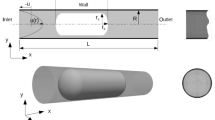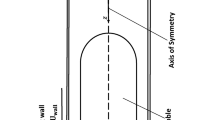Abstract
Eco-friendly and low-temperature liquid hydrogen has been used as propellants for the launching of rockets. As the low-temperature two-phase gas-liquid flow differs from room-temperature flows, studying the motion of bubbles in the liquid hydrogen fluid is of great importance. By using the volume of the fluid model on the Fluent software, we perform two-dimensional numerical modeling of single Taylor bubble rising movement and double Taylor bubbles coalescence in stagnant liquid hydrogen fluids in vertical and inclined pipe. The results are as follows: for a single Taylor bubble rising in a vertical and inclined pipe, the main hydrodynamic characteristics in the nose area, the liquid film area and the wake region of bubble are determined with the pipe diameter and the inclination angle. Secondly, for double Taylor bubbles rising in a pipe of different inclination angles, the velocity, length and shape of the leading bubble change little, but the velocity and length of the trailing bubbles reduce initially, then increase and reduce again as the separation distance becomes smaller. The research results are helpful to the study of slug flow patterns in cryogenic two-phase flow, and lay a theoretical foundation for the safe transportation of liquid hydrogen propellant in cryogenic pipelines.
























Similar content being viewed by others
Data Availability
All data, models, and code generated or used during the study appear in the submitted article.
References
Nagai H, Noda K (1992) Status of H-II rocket first stage propulsion system. J Propuls Power 8:313–319
Davies RM, Taylor GI (1950) The mechanics of large bubbles rising through extended liquids and through liquids in tubes. Proc R Soc London, Ser. A, 200–375
Brown RAS (1965) The mechanism of large bubbles in tubes. I. Bubble velocities in stagnantliquids. Can J Chem Eng 43:217–223
Nogueira S, Riethmuler ML, Campos JBLM, Pinto AMFR (2006a) Flow in the nose region and annular film around a Taylor bubble rising through vertical columns of stagnant and flowing Newtonian liquids. Chem Eng Sci 61:845–857
Campos JBLM, Guedes De Carvalho JRF (1988) An experimental study of the wake of gas slugs rising in liquids. J Fluid Mech 196:27–37
Araújo JDP, Miranda JM, Campos JBLM (2013) Flow of two consecutive Taylor bubbles through a vertical column of stagnant liquid—a CFD study about the influence of the leading bubble on the hydrodynamics of the trailing one. Chem Eng Sci 97:16–33
Massou EZ, Xiao Q, El-Gamal HA (2020) Numerical study of an individual Taylor bubble drifting through stagnant liquid in an inclined pipe. Ocean Eng 195:106648
Lu YP (2013) Experiments and numerical research on the flowing features and flow field structures of low temperature gas-liquid two-phase slug flows. Shanghai Jiaotong University. PhD dissertation
Fu X (2012) Visualization research on the flowing and boiling physical features and mechanisms of liquid nitrogen in mini-and micropipes. Shanghai Jiaotong University. PhD dissertation
Pinto AMFR, Coelho Pinheiro MN, Campos JBLM (1998) Coalescence of two gas slugs rising in a co-current flowing liquid in vertical tubes. Chem Eng Sci 53(16):2973–2983
Aladjem Talvy C, Shemer L, Barnea D (2000) On the interaction between two consecutive elongated bubbles in a vertical pipe. Int J Multiphase Flow. 26:1905–1923
Shemer L, Gulitski A, Barnea D (2007) Movement of two consecutive Taylor bubbles in vertical pipes. Multiphase Sci Technol 19(2):99–120
Sousa RG, Pinto AMFR, Campos JBLM (2007) Interaction between Taylor bubbles rising in stagnant non-Newtonian fluids. Int J Multiphase Flow 33:970–986
Dai XY et al (2013) Coalescence of Taylor bubbles in low-temperature gas-liquid two-phase fluids. Chin J Process Eng 13(5):776–780
Momeni DA, Esmail L, Mahdi H, Afrasyab K (2022) A modified model of the suction technique of wetness reducing in wet steam flow considering power-saving. J Energy 238:121685
Hoseinzade D, Lakzian E, Hashemian A (2021) A blackbox optimization of volumetric heating rate for reducing the wetness of the steam flow through turbine blades. J Energy 220:119751
Yazdani S, Lakzian E (2020) Numerical simulation and passive control of condensing flow through turbine blade by NVD Method Using Eulerian–Lagrangian Model. Computers & Mathematics with Applications
Rashidi S, Akar S, Bovand M, Ellahi R (2018) Volume of fluid model to simulate the nanofluid flow and entropy generation in a single slope solar still. Journal of Renewable Energy 115:400–410
Rashidi S, Bovand M, Esfahani JA (2018) Volume-of-Fluid Model for simulating Vapor–liquid phase change in a solar still. Journal of Thermophysics and Heat Transfer:1–8
Rashidi S, Akbarzadeh M, Karimi N, Masoodi R (2018) Combined effects of nanofluid and transverse twisted-baffles on the flow structures, heat transfer and irreversibilities inside a square duct – a numerical study. Journal of Applied Thermal Engineering 130:135–148
Van Hout R, Gulitski A, Barnea D, Shemer L (2002) Experimental investigation of the velocity field induced by a Taylor bubble rising in stagnant water. Int J Multiphase Flow. 28:579–596
Wallis GB (1969) One dimensional two-phase flow, Chaps. 9 and 10. McGraw-Hill
Viana F, Pardo R, Yánez R, Trallero JL, Joseph DD (2003) Universal correlation for the rise velocity of long gas bubbles in round pipes. J Fluid Mech 494:379–398
Funding
This study is funded by National Natural Science Foundation of China (11605136), the Natural Science Foundation of Shaanxi Province (2021JM-324), Special scientific Research Project of Education Department of Shaanxi Province(21JK0780), Science and Technology Project of Xi ‘an Beilin District(GX2109), Science and Technology Project Funded by Shaanxi Provincial Department of Water Resources(2020slkj-10).
Author information
Authors and Affiliations
Corresponding author
Ethics declarations
Conflict of Interest
The authors declare that they have no competing interest.
Additional information
Publisher’s Note
Springer Nature remains neutral with regard to jurisdictional claims in published maps and institutional affiliations.
Appendix
Appendix
The experimental device (Fig. 4) includes an air and water supply system and a test section made of a vertical plexiglass tube with a diameter of 25 mm and a diameter of approximately 170 mm. Filtered tap water is used as a working fluid in a closed circulating flow, and air is supplied by a central compressed air pipe at a nominal pressure of 0.4 MPa. Inject air with a pressure of 0.4pa into the pipe to generate Taylor bubbles of different lengths as required. In order to eliminate the error caused by the injection, the measurement was performed at a distance of 2 m from the entrance; the measurement area of the pipe was sealed with a transparent rectangular plexiglass box filled with water to avoid image distortion. A small amount of almost neutral buoyancy (specific gravity 0.95) silicone rubber particles with a diameter of 20,000–40,000 nm was added to the water, and the velocity field in the liquid around the Taylor bubble was measured by PIV. At the beginning of each test run, refill the pipes with water, and sufficient time has passed between consecutive test runs to ensure that residual flow disturbances are controlled. The output video signals of the two cameras are ignored and connected to the frame through the commutator box. Capture the board. In order to ensure the necessary synchronization between various devices, such as bubble injection, switching between cameras and recording processes, they are all controlled by the clock of the same PC. The image is recorded only when the bubble passes through the field of view of the corresponding camera. Find the outline of the bubble through the edge detection algorithm (respectively for the head and bottom of the bubble). Apply this procedure to each recorded frame to obtain a sequence of 100–200 bubble shape contours for each moving bubble.
Nomenclature The following symbols are used in this paper:
t: time
p: pressure
U: velocity vector
g: gravitational acceleration
T : temperature
μ: dynamic viscosity
Mo: morton number
N f : inverse viscosity number
Fr: froude number
Eo: eötvös number
R G: buoyancy reynolds number
σ: surface tension
D: tube diameter
θ: tube inclination angles
z: axial coordinates
r: radial coordinate
Z’: the distance from the Taylor bubble nose tip to the stable flow field afront the bubble
u z: axial component of the rising velocity
u r: radial component of the rising velocity
u: the rising velocity of the Taylor bubble
R tb: the maximum radius of the Taylor bubble
Z* : the length from the bubble nose to the stable liquid film
δ : the thickness of the stable liquid film
τ ω: the wall shear stress
L min: the length from the bubble tail to the stable flow field downstream the bubble tail
Rights and permissions
About this article
Cite this article
Zuo, J., Zhang, K., Wu, S. et al. Numerical Modeling of Movements of Taylor Bubbles in Stagnant Liquid Hydrogen Fluids. Exp Tech 47, 235–252 (2023). https://doi.org/10.1007/s40799-021-00522-9
Received:
Accepted:
Published:
Issue Date:
DOI: https://doi.org/10.1007/s40799-021-00522-9




